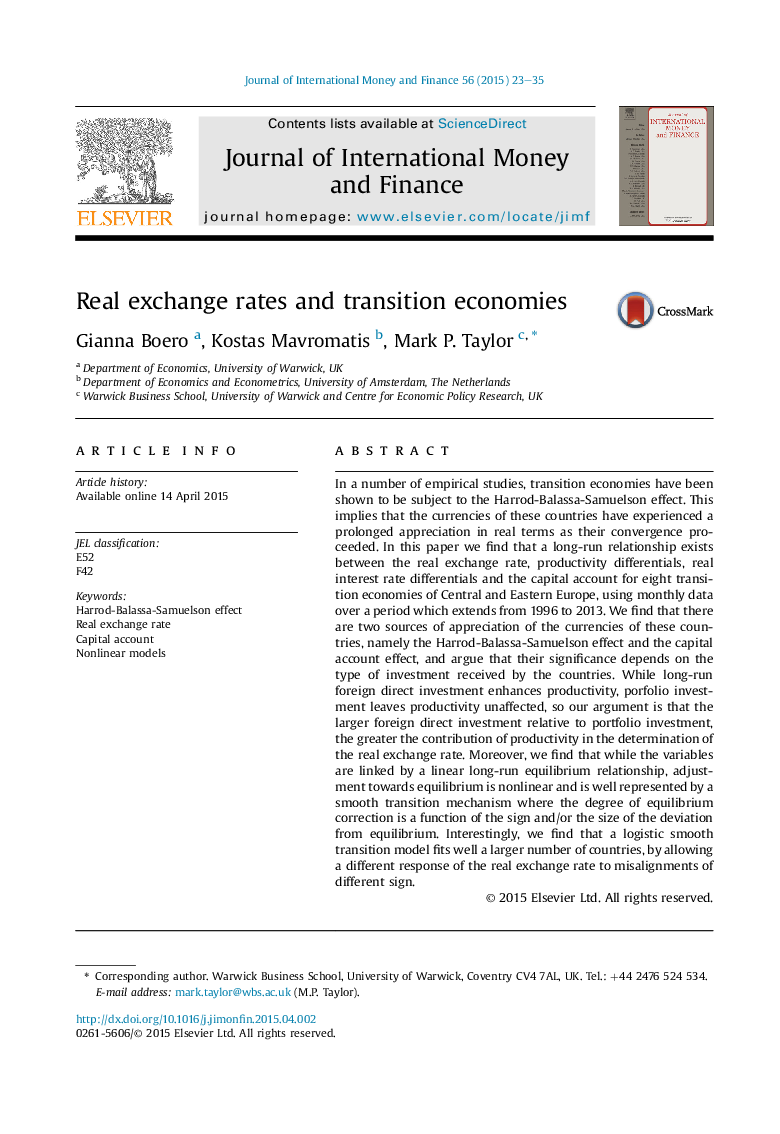| کد مقاله | کد نشریه | سال انتشار | مقاله انگلیسی | نسخه تمام متن |
|---|---|---|---|---|
| 963350 | 1479162 | 2015 | 13 صفحه PDF | دانلود رایگان |
عنوان انگلیسی مقاله ISI
Real exchange rates and transition economies
ترجمه فارسی عنوان
نرخ ارز واقعی و اقتصاد گذار
دانلود مقاله + سفارش ترجمه
دانلود مقاله ISI انگلیسی
رایگان برای ایرانیان
کلمات کلیدی
ترجمه چکیده
در تعدادی از مطالعات تجربی، اقتصادهای در حال گذار نشان داده شده است که موضوع اثر هارود بلاسا ساموئلسون است. این بدان معنی است که ارزهای این کشورها در زمان واقعی به دلیل درهم آمیخته شدن آنها، قدردانی طولانی مدت را تجربه کرده اند. در این مقاله متوجه می شویم که رابطه طولانی مدت بین نرخ واقعی ارز، تفاوت های بهره وری، تفاوت نرخ بهره واقعی و حساب سرمایه برای هشت اقتصاد گذار اروپای مرکزی و شرقی با استفاده از داده های ماهانه در دوره ای که از سال 1996 تا 2013. ما دریافتیم که دو منبع ارزشی از ارزهای این کشورها وجود دارد، یعنی اثر هارود - بالاسا - ساموئلسون و اثر حساب سرانه، و استدلال می کنند که اهمیت آنها بستگی به نوع سرمایه گذاری دریافت شده توسط کشورها دارد. در حالی که سرمایه گذاری مستقیم خارجی درازمدت باعث افزایش بهره وری می شود، سرمایه گذاری در بخش سرمایه گذاری بازده بهره وری را از بین می برد، بنابراین استدلال ما این است که سرمایه گذاری مستقیم خارجی بزرگتر نسبت به سرمایه گذاری های نمونه کارها، سهمی از بهره وری در تعیین نرخ ارز واقعی است. علاوه بر این، ما متوجه می شویم که در حالی که متغیرها با یک رابطه تعادلی طولانی مدت مرتبط هستند، تنظیم نسبت به تعادل غیرخطی است و به خوبی با مکانیزم انتقال صاف نشان داده شده است که در آن درجه اصلاح تعادل یک تابع نشانه و یا اندازه از انحراف از تعادل. جالب توجه است، ما دریافتیم که یک مدل انتقال مداوم منطقی منطبق با تعداد بیشتری از کشورها، با اجازه دادن به پاسخ متفاوت از نرخ واقعی ارز به ناهماهنگی نشانه های مختلف است.
موضوعات مرتبط
علوم انسانی و اجتماعی
اقتصاد، اقتصادسنجی و امور مالی
اقتصاد و اقتصادسنجی
چکیده انگلیسی
In a number of empirical studies, transition economies have been shown to be subject to the Harrod-Balassa-Samuelson effect. This implies that the currencies of these countries have experienced a prolonged appreciation in real terms as their convergence proceeded. In this paper we find that a long-run relationship exists between the real exchange rate, productivity differentials, real interest rate differentials and the capital account for eight transition economies of Central and Eastern Europe, using monthly data over a period which extends from 1996 to 2013. We find that there are two sources of appreciation of the currencies of these countries, namely the Harrod-Balassa-Samuelson effect and the capital account effect, and argue that their significance depends on the type of investment received by the countries. While long-run foreign direct investment enhances productivity, porfolio investment leaves productivity unaffected, so our argument is that the larger foreign direct investment relative to portfolio investment, the greater the contribution of productivity in the determination of the real exchange rate. Moreover, we find that while the variables are linked by a linear long-run equilibrium relationship, adjustment towards equilibrium is nonlinear and is well represented by a smooth transition mechanism where the degree of equilibrium correction is a function of the sign and/or the size of the deviation from equilibrium. Interestingly, we find that a logistic smooth transition model fits well a larger number of countries, by allowing a different response of the real exchange rate to misalignments of different sign.
ناشر
Database: Elsevier - ScienceDirect (ساینس دایرکت)
Journal: Journal of International Money and Finance - Volume 56, September 2015, Pages 23-35
Journal: Journal of International Money and Finance - Volume 56, September 2015, Pages 23-35
نویسندگان
Gianna Boero, Kostas Mavromatis, Mark P. Taylor,
